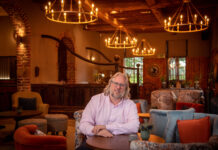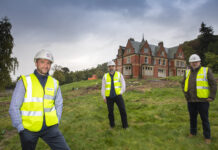
A GROUND-BREAKING agri-environment project that has been running for the last four years has united Wales’s common land graziers, safeguarded a vast tract of countryside and provided £35 million into the Welsh rural economy.
The Glastir Common Development Officers project was launched in 2011 to help farmers and graziers on common land to access support under the Welsh Government Glastir agri-environment scheme.
Over the course of the scheme it has helped to secure the sustainable management of over 100,000 hectares of common land, over 70 per cent of the Wales total, new graziers associations have been established or reconstituted and 198 Glastir Common Land agreements have been reached.
The scheme was co-funded by the European Agricultural Fund for Rural Development (EAFRD) and the Welsh Government through the Rural Development Plan for Wales 2007 – 2013.
The project has been a resounding achievement, according to an independent evaluation which has attributed its success to the work of three rural regeneration agencies Denbighshire-based Cadwyn Clwyd, Menter Mon, from Anglesey, and Pembrokeshire’s PLANED.
They oversaw the project and appointed a team of 18 Commons Development Officers (CDOs) across Wales to act as facilitators between Welsh Government and local farmers.
Heading up the teams were CDO Supervisors Dan Delaney, of Cadwyn Clwyd, Robin Griffiths, Menter Mon, and Steven Bradley, PLANED.
Dan Delaney, who comes from a National Trust background, explained the importance of the job.
“Essentially it’s a sustainable land management scheme that pays farmers for activities that bring about environmental benefits” he said.
“Previously, there had been very low uptake of common land in agri-environment schemes, but, by the end of our first year, we had 106 organisations formed and applying for funding.
“That was a revolution in both the approach and in the rate of success.”
The challenge for the supervisors and their teams was to identify all those with an interest in the common and to organise them into constituted groups.
They needed establishing, administrating, advice on meetings, book-keeping, paperwork and a proper committee forming before the CDOs could then steer them towards the correct funding applications.
Dan said: “In some cases there were over 100 people holding rights to grazing on a piece of land so it was often a slow and steady process.
“We were the go-betweens. Often chairing lively debates and sometimes helping to negotiate compromises.
“But our approach was that every person was different and every common was different and what was suitable in one area or for one group of farmers wasn’t necessarily the case for someone or somewhere else.”
All the CDOs employed for the Glastir project came from agricultural and land management backgrounds and worked within their own local communities.
This enabled them to understand the people and the challenges involved as well as allowing meetings to take place in evenings or on weekends so the timings could accommodate the farming communities.
Steven Bradley, PLANED CDO Supervisor, said: “We have now enabled the groups we formed to help themselves, have given them our expertise and are weaning them off to go forward and access this government funding as community-based groups.”
The support provided through the CDO on Common land was so successful that it evolved to provide support for Glastir Entry – a customer-led scheme – and Glastir Advanced – a selection based environmental scheme, which eventually involved all of those already part of the common scheme.
Robin Griffiths, Menter Mon Supervisor, said: “A major plus has been that through the discussions to come to a Glastir Commons agreement the graziers have realised that there are great benefits to be gained from working together as a Grazing Association.
“Graziers have always worked together to gather the sheep but the Glastir Commons Project has formalised these arrangements and they have seen the advantages to be gained and this will stand them in good stead for the future when other opportunities may arise to co-operate with each other.”
The success of the Glastir Common Scheme has been three-fold – financial, environmental and cultural.
Financially for every million pounds put in to the project, £10 million has been put back into the economy, as administering the CDO service cost just £3.5 million.
Dan said: “Not only has there been £35 million spent on environmental projects, the money paid out is also is being spent in local communities.
“The environmental impact for the 100,000 hectares of common land is huge and the cultural results are vital too.
“The amount of breaking down of barriers we have done is immeasurable. We have operated independently to bring together some quite diverse groups whether it be government bodies, farmers or land owners.
“Now these groups have been established the structures should be in place for them to build on in the future and that is of huge value to both individuals and communities throughout Wales,” he added.


























